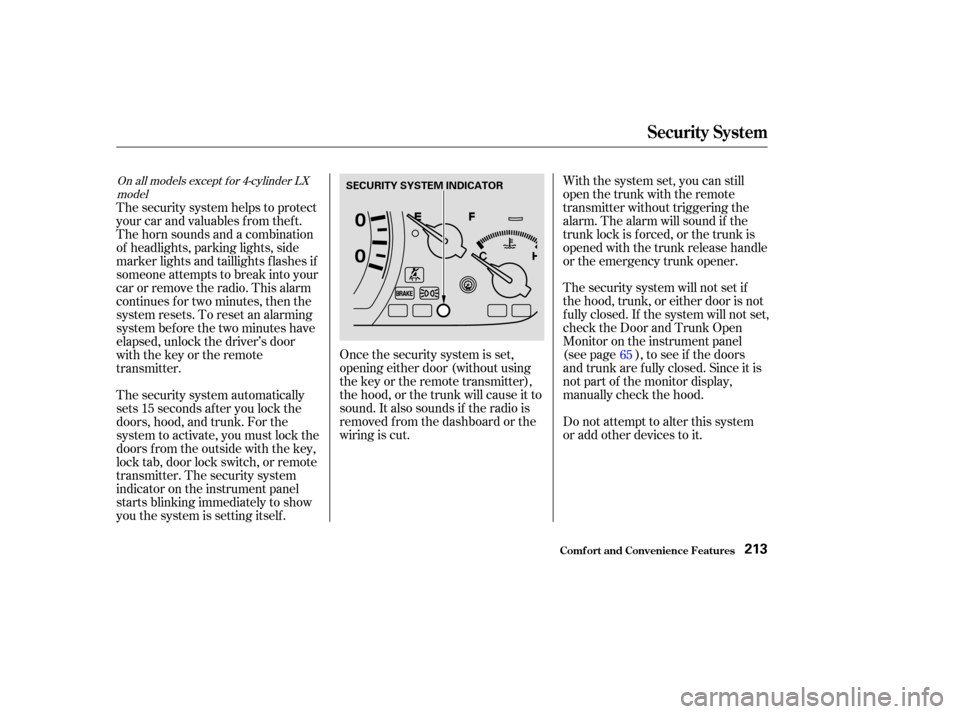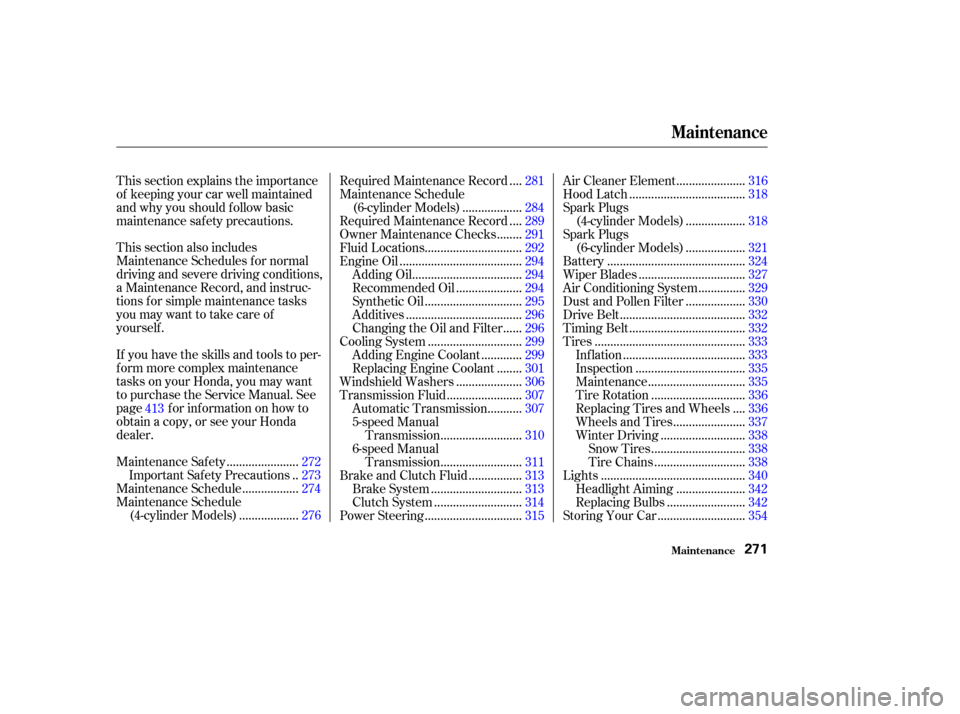2003 HONDA ACCORD COUPE ECO mode
[x] Cancel search: ECO modePage 216 of 429

Do not attempt to alter this system
or add other devices to it.
Once the security system is set,
opening either door (without using
the key or the remote transmitter),
the hood, or the trunk will cause it to
sound. It also sounds if the radio is
removed f rom the dashboard or the
wiring is cut. With the system set, you can still
open the trunk with the remote
transmitter without triggering the
alarm. The alarm will sound if the
trunk lock is f orced, or the trunk is
opened with the trunk release handle
or the emergency trunk opener.
The security system will not set if
the hood, trunk, or either door is not
f ully closed. If the system will not set,
check the Door and Trunk Open
Monitor on the instrument panel
(see page ), to see if the doors
and trunk are f ully closed. Since it is
notpartofthemonitordisplay,
manually check the hood.
The security system helps to protect
your car and valuables f rom thef t.
The horn sounds and a combination
of headlights, parking lights, side
marker lights and taillights f lashes if
someone attempts to break into your
carorremovetheradio.Thisalarm
continues f or two minutes, then the
system resets. To reset an alarming
system bef ore the two minutes have
elapsed, unlock the driver’s door
with the key or the remote
transmitter.
The security system automatically
sets 15 seconds after you lock the
doors, hood, and trunk. For the
system to activate, you must lock the
doors f rom the outside with the key,
lock tab, door lock switch, or remote
transmitter. The security system
indicator on the instrument panel
starts blinking immediately to show
you the system is setting itself .
65
On all models except f or 4-cylinder LX
model
Security System
Comf ort and Convenience Feat ures213
SECURITY SYSTEM INDICATOR
Page 220 of 429

If your garage door opener was
manuf actured bef ore April 1982, you
may not be able to program
HomeLink to operate it. Garage door
openers manuf actured bef ore that
date do not have a safety feature that
causes them to stop and reverse if an
obstacle is detected during closing,
increasing the risk of injury. If you
have questions, call (800) 355-3515. HomeLink stores the code in a
permanent memory. There should
be no need to retrain HomeLink if
your car’s battery goes dead or is
disconnected.
The HomeLink Wireless Control
System built into your car can be
programmed to operate remotely-
controlled devices around your home,
such as garage doors, lighting, or
home security systems. It can
replaceuptothreeremote
transmitters.
If you have problems with training
the HomeLink Wireless Control
System, or would like inf ormation on
home products that can be operated
by the transmitter, call (800) 355-
3515. On the Internet, go to www.
homelink.com. Always ref er to the operating
instructions and saf ety inf ormation
that came with your garage door
opener or other equipment you
intend to operate with HomeLink. If
you do not have this inf ormation, you
should contact the manuf acturer of
the equipment.
For quick and accurate training,
make sure the remote control
transmitter for the device (garage
door, automatic gate, security
system, etc.) has a fresh battery.
While training or using HomeLink,
make sure you have a clear view of
the garage door or gate, and that no
one will be injured by its movement.
If you are training HomeLink to
operate a garage door or gate, it is
recommended that you unplug the
motor f or that device during training.
Repeatedly pressing the remote
control button could burn out the
motor.
On EX-V6 modelImportant Saf ety Precautions
Customer Assistance General Inf ormation
HomeL ink Wireless Control System
Comf ort and Convenience Feat ures217
Page 227 of 429

During this period:Avoid full-throttle starts and rapid
acceleration.
Avoidhardbraking.Newbrakes
need to be broken-in by moderate
use f or the f irst 200 miles (300
km).
Help assure your car’s f uture
reliability and perf ormance by paying
extra attention to how you drive
during the f irst 600 miles (1,000 km).
Youshouldfollowthesesamere-
commendations with an overhauled
or exchanged engine, or when the
brakes are relined.
Do not change the oil until the
recommended time or mileage
intervalshowninthemaintenance
schedule. Your Honda is designed to operate
on unleaded gasoline with a pump
octane number of 86 or higher. Use
of a lower octane gasoline can cause
a persistent, heavy metallic rapping
noise in the engine that can lead to
mechanical damage.
In Canada, some gasolines contain
an octane-enhancing additive called
MMT. If you use such gasolines,
your emission control system
perf ormance may deteriorate and
the Malf unction Indicator Lamp on
your instrument panel may turn on.
If this happens, contact your
authorized Honda dealer f or service.
Using gasoline containing lead will
damage your vehicle’s emissions
controls. This contributes to air
pollution. We recommend gasolines containing
detergent additives that help prevent
f uel system and engine deposits. If you drive with the low engine
speed (below than about 1,000 rpm),
you may f eel the engine knocking. In
this case, you can use premium
unleaded gasoline with a pump
octane number of 91 or higher to
prevent the engine f rom knocking.
On EX-V6 with manual transmission
Bef ore Driving
Break-in Period Gasoline
Break-in Period, Gasoline
224
Page 234 of 429

A cold engine uses more f uel than a
warm engine. It is not necessary to
‘‘warm-up’’ a cold engine by letting it
idle f or a long time. You can drive
away in about a minute, no matter
how cold it is outside. The engine
will warm up f aster, and you get
better f uel economy. To cut down on
the number of ‘‘cold starts,’’ try to
combine several short trips into one.
You can improve f uel economy by
driving moderately. Rapid acceler-
ation, abrupt cornering, and hard
braking use more f uel.
Always drive in the highest gear that
allows the engine to run and acceler-
ate smoothly.
The air conditioning puts an extra
load on the engine which makes it
usemorefuel.Turnoff theA/Cto
cut down on air conditioning use.
Use the f low-through ventilation
when the outside air temperature is
moderate.
The condition of your car and your
driving habits are the two most
important things that affect the fuel
mileage you get.
Always maintain your car according
to the maintenance schedule. This
will keep it in top operating condition.
Depending on traf f ic conditions, try
to maintain a constant speed. Every
time you slow down and speed up,
your car uses extra f uel. Use the
cruise control, when appropriate, to
increase f uel economy.
An important part of that mainte-
nance is the
(see page ). For
example, an underinf lated tire
causes more ‘‘rolling resistance,’’
which uses f uel. It also wears out
f aster, so check the tire pressure at
least monthly.
In winter, the build-up of snow on
your car’s underside adds weight and
rolling resistance. Frequent cleaning
helps your f uel mileage and reduces
thechanceof corrosion. 291 Driving Habits
Owner Maintenance
Checks Car Condition
Fuel Economy
Bef ore Driving231
Page 246 of 429

Come to a full stop before you shift
into Reverse. You can damage the
transmission by trying to shif t into
Reverse with the car moving. Push
down the clutch pedal, and pause f or
a f ew seconds bef ore shif ting into
Reverse, or shif t into one of the
f orward gears f or a moment. This
stops the gears so they won’t ‘‘grind.’’
When slowing down, you can get
extra braking f rom the engine by
shifting to a lower gear. This extra
braking can help you maintain a safe
speed and prevent your brakes f rom
overheating while going down a
steep hill. Bef ore downshif ting,
make sure engine speed will not go
into the tachometer’s red zone in the
lower gear.
The manual transmission is syn-
chronizedinallforwardgearsfor
smooth operation. It has a lockout so
you cannot shift directly from Fifth
to Reverse. When shif ting up or
down,makesureyoupushtheclutch
pedal down all the way, shift to the
next gear, and let the pedal up
gradually. When you are not shif ting,
do not rest your f oot on the clutch
pedal. This can cause your clutch to
wear out faster.
On all 4-cylinder models
Driving
5-speed Manual T ransmission
243
Rapid slowing or speeding-up
can cause loss of control on
slippery surfaces. If you crash,
you can be injured.
Use extra care when driving on
slippery surfaces.
Page 248 of 429

The manual transmission is synchro-
nizedinallforwardgearsforsmooth
operation. It has a lockout so you
cannot shift directly from Fifth to
Reverse instead of Sixth (see page). When shif ting up or down,
make sure you push the clutch pedal
down all the way, shift to the next
gear, and let the pedal up gradually.
When you are not shif ting, do not
rest your f oot on the clutch pedal.
This can cause your clutch to wear out f aster.
Come to a full stop before you shift
into Reverse. You can damage the
transmission by trying to shif t into
Reverse with the car moving. Push
down the clutch pedal, and pause f or
a f ew seconds bef ore shif ting into
Reverse, or shif t into one of the
f orward gears f or a moment. This
stops the gears so they won’t ‘‘grind.’’
When slowing down, you can get
extra braking f rom the engine by
shifting to a lower gear. This extra
braking can help you maintain a safe
speed and prevent your brakes f rom
overheating while going down a
steep hill. Bef ore downshif ting,
make sure engine speed will not go
into the tachometer’s red zone in the
lower gear.
Your car is equipped with an
aluminum shif t lever. If you leave the
car parked outside f or a long time on
a hot day, be caref ul bef ore moving
the shif t lever. Because of the heat,
the shif t lever may be extremely hot.
If the outside temperature is low, the
shif t lever f eels cold.
246
On EX-V6 model
6-speed Manual T ransmission
Driving245
Rapid slowing or speeding-up
can cause loss of control on
slippery surfaces. If you crash,
you can be injured.
Use extra care when driving on
slippery surfaces.
Page 274 of 429

This section also includes
Maintenance Schedules f or normal
driving and severe driving conditions,
a Maintenance Record, and instruc-
tions f or simple maintenance tasks
you may want to take care of
yourself .
If you have the skills and tools to per-
f orm more complex maintenance
tasks on your Honda, you may want
to purchase the Service Manual. See
page f or inf ormation on how to
obtain a copy, or see your Honda
dealer. This section explains the importance
of keeping your car well maintained
andwhyyoushouldfollowbasic
maintenance saf ety precautions.......................
Maintenance Saf ety .272
.
Important Safety Precautions . 273
.................
Maintenance Schedule . 274
Maintenance Schedule ..................
(4-cylinder Models) . 276 ...
Required Maintenance Record . 281
Maintenance Schedule ..................
(6-cylinder Models) . 284
...
Required Maintenance Record . 289
.......
Owner Maintenance Checks . 291
..............................
Fluid Locations .292
......................................
Engine Oil .294
..................................
Adding Oil .294
....................
Recommended Oil .294
..............................
Synthetic Oil .295
....................................
Additives .296
.....
Changing the Oil and Filter . 296
.............................
Cooling System .299
............
Adding Engine Coolant . 299
.......
Replacing Engine Coolant . 301
....................
Windshield Washers .306
.......................
Transmission Fluid .307
..........
Automatic Transmission . 307
5-speed Manual .........................
Transmission .310
6-speed Manual .........................
Transmission .311
................
Brake and Clutch Fluid . 313
............................
Brake System .313
...........................
Clutch System .314
..............................
Power Steering .315 .....................
Air Cleaner Element .316
....................................
Hood Latch .318
Spark Plugs ..................
(4-cylinder Models) . 318
Spark Plugs ..................
(6-cylinder Models) . 321
...........................................
Battery .324
.................................
Wiper Blades .327
..............
Air Conditioning System . 329
..................
Dust and Pollen Filter . 330
.......................................
Drive Belt .332
....................................
Timing Belt .332
...............................................
Tires .333
......................................
Inf lation .333
..................................
Inspection .335
..............................
Maintenance .335
.............................
Tire Rotation .336
...
Replacing Tires and Wheels . 336
......................
Wheels and Tires .337
..........................
Winter Driving .338
.............................
Snow Tires .338
............................
Tire Chains .338
.............................................
Lights .340
.....................
Headlight Aiming .342
........................
Replacing Bulbs .342
...........................
Storing Your Car .354
413
Maintenance
Maint enance271
Page 284 of 429

CONT INUED
Maint enance
Required Maintenance Record f or 4-cylinder Models (Normal and Severe Schedules)
281
30,000 mi
35,000 mi
40,000 mi
45,000 mi
50,000 mi
5,000 mi
10,000 mi
15,000 mi
20,000 mi
25,000 mi Signature or dealer stamp
Signature or dealer stamp
You or the servicing dealer can record all completed maintenance here, whether you follow the schedule for normal conditions (page ) or severe
conditions (page ). Keep the receipts for all work done on your car.
48,000 km
56,000 km
64,000 km
(or 2 years)
72,000 km
80,000 km
8,000 km
16,000 km
24,000 km
32,000 km
(or 1 year)
40,000 km mi/km
mi/km
mi/km
mi/km
mi/km
mi/km
mi/km
mi/km
mi/km
mi/km
Date
Date
Date
Date
Date Date
Date
Date
Date
Date
278
276